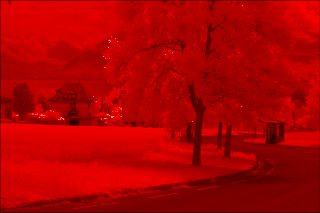Seeing infrared
My former advisor at NYU, Ken Perlin, posted a cool suggestion. Our eyes are good at adapting to modified spectra. So what if we squashed all the colors of the spectrum into the green-blue end, and opened up some space at the red end of the spectrum to include infrared? This isn't that hard to do in Photoshop. You download an RGB to HSB filter, adjust the output of the Hue channel levels, and then add the infrared image as a layer using the "linear dodge (add)" blending mode. Of course, you need an RGB and infrared of the same scene.
This is the near-infrared image of the scene, shown as red.
This is the original RGB image.
This is the spectrum-squashed RGB image.
Here is the final result. What has a reddish cast to it is giving off more near-infrared light. This tends to be the sky, the leaves of trees, grass, and people's skin.
Since the transformation I did changes red to yellow, you can get yellow in two ways-- infra-red plus green, and normal red light. Since ordinarily yellow comes from red plus green or true yellow light, I don't see this as a big problem.






Comments
Here is someone's personal experience with it.
http://www.komar.org/faq/colorado-cataract-surgery-crystalens/ultra-violet-color-glow/